1958 Belgian Grand Prix race report: Brooks becomes an F1 winner
Vanwall pilot Tony Brooks takes his debut win ahead of compatriots Mike Hawthorn and Stuart Lewis-Evans at Spa Francorchamps in the 1958 Belgian Grand Prix
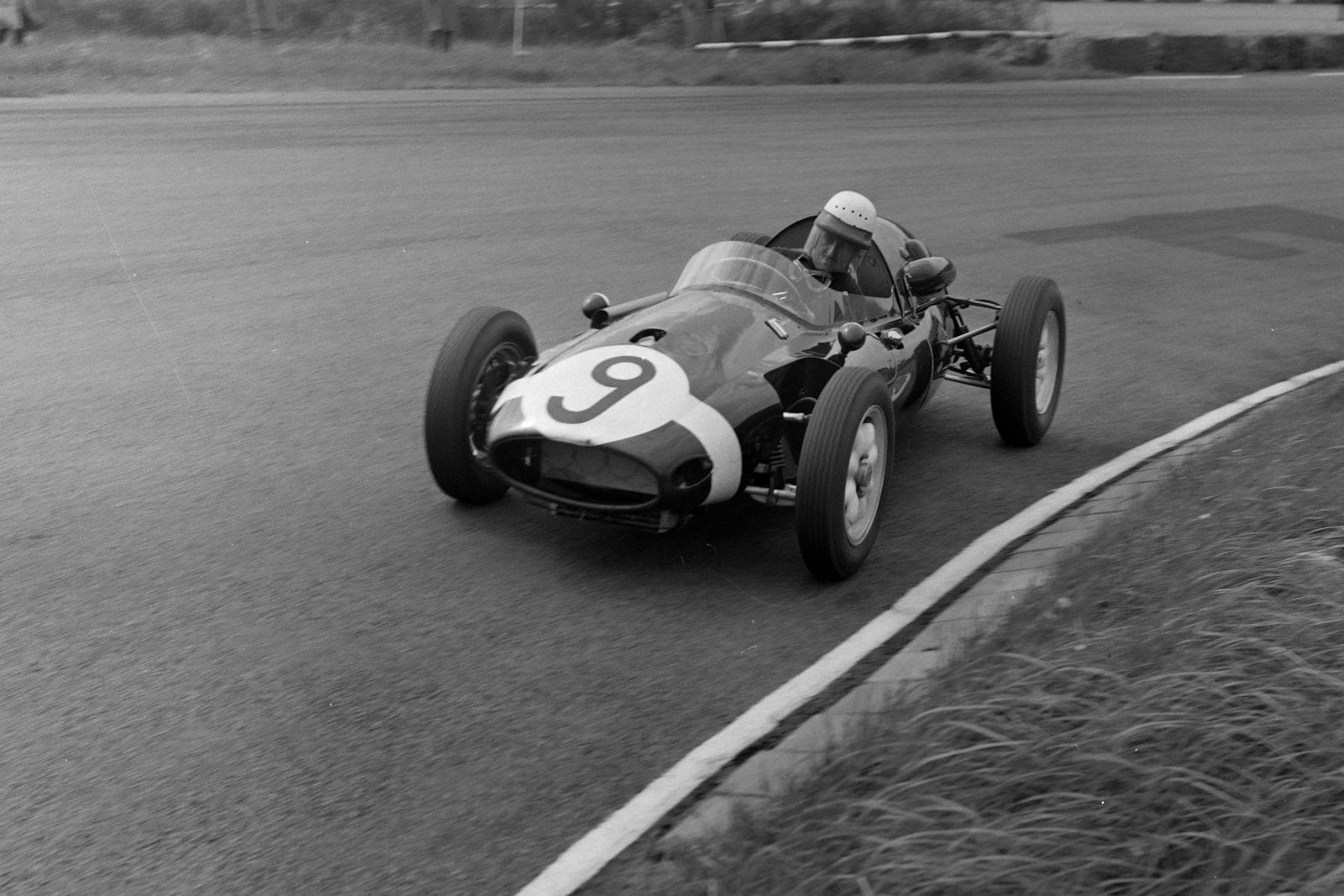
Maurice Trintignant in his Cooper T45 Climax
Motorsport Images
After spending a great deal of money last year rebuilding the pits and paddock and modifying the circuit considerably, easing corners, removing bumps, widening the road and re-surfacing, all the work was to no avail for financial wrangles prevented the Belgian GP being held in 1957. However, this year all was well and the full Grand Prix circus was entered.
After the Dutch GP at Zandvoort the Vanwall team were favourites, though the V6 Ferraris could not be overlooked, for this being their first race on a really high-speed circuit it was going to give them a chance to show if their high power output claims were really true. Since the last occasion on which Grand Prix cars ran at Spa so many changes have been made to the circuit and the cars that no comparisons are possible, the only figure available as a guide before practice started being the fastest sports-car lap recorded by Gendebien with a 4.1-litre Ferrari in 4min 9.8sec last August on the modified circuit.
Qualifying
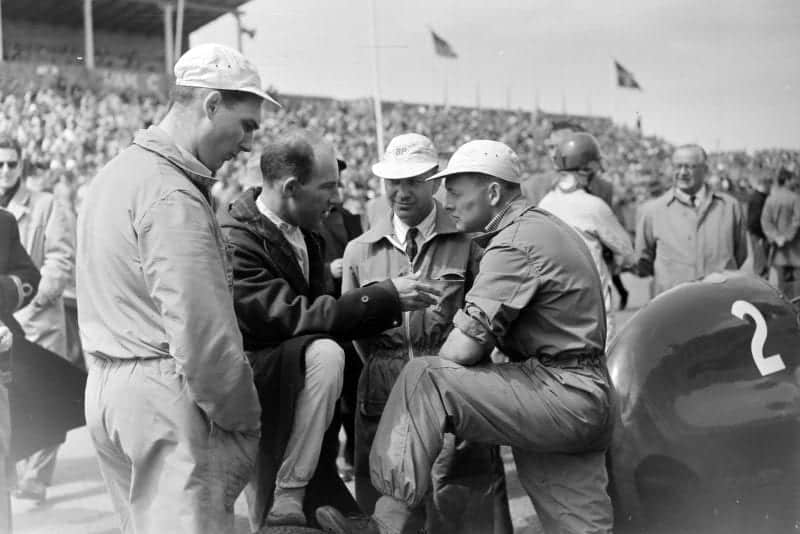
Stirling Moss speaks with mechanics before the race
Motorsport Images
With the roads used for the circuit being part of the everyday road system around the area between Francorchamps and Stavelot, practising was limited to a two-hour session for each of the three days preceding the race, and on Thursday evening Vanwall, Ferrari, BRM and Cooper team cars appeared and one lone Maserati.
Vanwall had three cars for Moss, Brooks and Lewis-Evans, the team leader having a car fitted with 17″ diameter wire-spoke wheels, the other two having 16″ diameter alloy wheels.
Ferrari had four Dino 246 cars out, two with the heavier Formula 1 chassis frame and two with the lighter Formula 2 frame, and all had new air intakes for the sets of three downdraught double-choke Weber Carburetters. In the past Ferrari has tried a Perspex screen round the carburetters with an opening at the top, a Perspex bubble with an opening at the rear, and now they had aluminium covers with front openings.
Hawthorn, Collins and Musso were the drivers and, if all went well, Gendebien was to have the fourth car. BRM had two 1958 cars for Behra and Schell and a 1957 car as spare, for Flockhart’s crash at Rouen prevented him making up the full Bourne team.
Cooper had two entries but only Salvadori was out on this first evening, for Brabham was suffering from a cold, so he drove both cars, one having a 2.2-litre engine, the other a 1.96-litre engine.
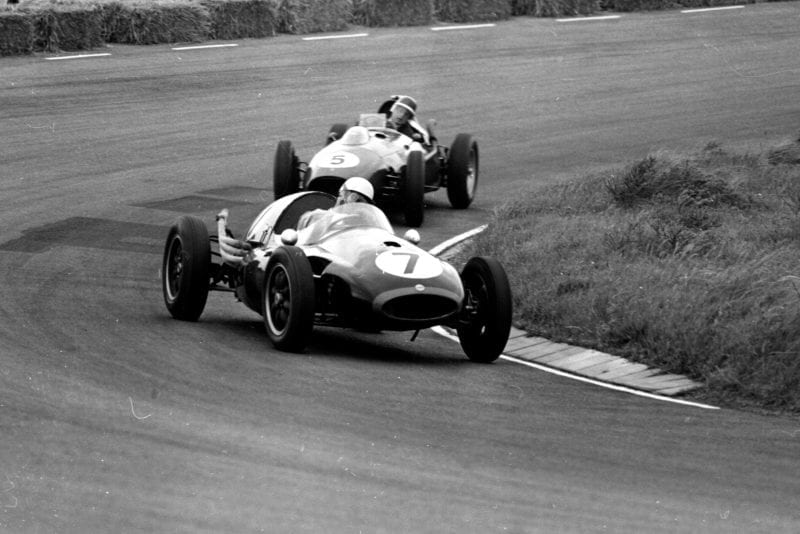
Roy Salvadori driving a Cooper T45 Climax, leads Mike Hawthorn in his Ferrari 246.
Motorsport Images
Although seven Maseratis were entered by private owners, only Kavanagh turned out on Thursday evening for a few slow laps, and in fact, practice opened on a very gentle note as drivers “felt” their way round this ultra-high-speed circuit. The BRMs were the first to show any signs of speed when they began lapping in times around 4min 20sec, but it was not long before the Vanwalls began to get wound up, and Brooks got down below 4min 10sec and finally settled for 4min 06sec, which was something near the sort of lap time everyone expected.
“Hawthorn lapped in 4min 06sec, so everyone really sat up and took notice”
The Ferraris had been touring round like the BRMs until the show of speed by the Vanwalls stirred things up and Hawthorn found himself in close company with Moss, whereupon each driver tried to either show how good his car was, or not let the other one see how fast he could really go. While indulging in this little game of hide-and-seek, Hawthorn lapped in 4min 06sec, so everyone really sat up and took notice. When he came in there was no one more surprised at the lap time than Hawthorn himself, so after a pause to let things settle down again he went out and really put the cat among the pigeons, or, more correctly, the Ferrari among the Vanwalls, with a lap in 4min 00.0sec, an average speed of 210.9kph.
Meanwhile the BRM team were not very happy, for, apart from not having enough speed on the very fast straights to improve on 4min 20sec, Behra haul got himself into real trouble. Entering the 145mph ess-bend on the Masta straight he got into a slide, due to oil on the rear tyres, and went right through the left-hand curve on full right lock and then through the following right-hand curve sideways on full left-hand lock and, just as it seemed like was going to get away with it the nose of the car struck a hedge, the cowling and radiator were torn off and be spun to rest, shaken but unhurt.
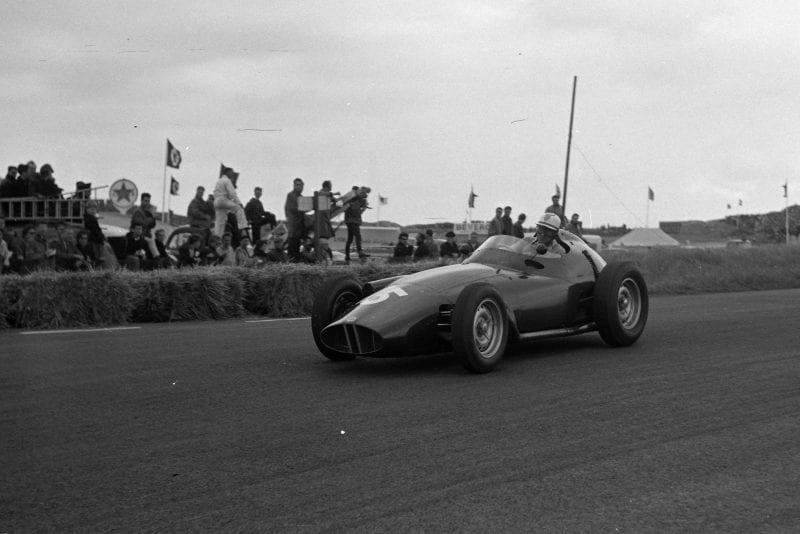
Harry Schell driving his BRM P25.
Motorsport Images
Schell went round in his BRM and collected his team-mate and brought him back to the pits, but there wasn’t much enthusiasm for trying to challenge Hawthorn’s fastest lap. The Vanwall team, on the other band, were on their mettle and Moss and Brooks tried hard to approach the Ferrari time but could not. Being the first practice period the handling was not yet 100 per cent for such speeds, nor were the gear ratios right for chopping off the last few seconds, se Moss had to be content with 4min 04.8sec and Brooks with 4min 05.6sec, though they were both faster than Musso and Collins, while Lewis-Evans was next, this being Isis first visit to Francorchamps. Activity on this first evening had not been terrific and seldom is, but Hawthorn’s time augured well for the following practice periods.
Friday practice was again from 6pm to 8pm and conditions were warm and dry, and this time Ferraris had painted their fourth car bright yellow, the Belgian racing colour, and it was driven by Gendebien. BRM had not repaired Behra’s car, so he was out in the old practice car with little hope of joining in on the top dicing, but Vanwalls were all set for battle, being better geared and prepared to experiment with different size tyres and wheels to try the effects on steering and roadholding. Brabham was out in the 2.2-litre Cooper and Salvadori in the smaller one, while Lotus had arrived with their two single-seaters for Allison and Hill.
A long line of Maseratis were in front of the pits, three under the banner of Centro-Sud for Gregory, Seidel and Trintignant, the last actually being Gerini’s car on loan, the privately-owned ones of Bonnier, Godia, Kavanagh and Signorina de Filippis, and another one bearing the letter L in place of a number. This car was a brand new six-cylinder; shorter lighter and smaller than the normal 250F, and while all the Maserati drivers were standing around wishing it were theirs, drivers and engineers from other teams were sniffing around to find out what it was all about. Meanwhile the Maserati factory people, Ugolini and Bertocchi, were trying to look as if it was nothing to do with them, for everyone knows that Maserati have given up racing, officially!
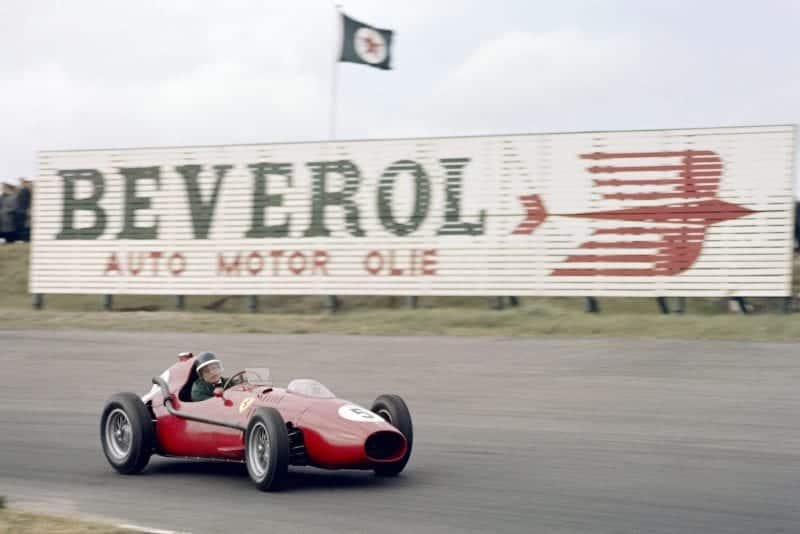
Mike hawthorn piloting his Ferrari D246.
Motorsport Images
As soon as practice was under way, Hawthorn set the ball rolling with 4min 02.5sec, but though he tried hard he could not approach his time of the day before, for he now had a different rear-axle ratio and though the car was better on the return run from Stavelot to the pits it was not so good on the fast outward run. Collins was at last getting into his stride and beginning to throw the Ferrari about its beautiful controlled slides, and the result was an equalling of Hawthorn’s 4min 00.6sec, while Musso was steadily working his way towards some really fast times.
Vanwalls made a rather hesitant start, but then Brooks showed that all was going well and did 4min 01.7sec, though Moss was still lapping around 4min 07sec and not very happy with the handling of his car, and Lewis-Evans was not really in the picture, even though he had made the creditable time of 4min 08sec.
“Most of the Maseratis seemed to be creeping round, if lap speeds of over 110mph can be called ‘creeping’”
Most of the Maseratis seemed to be creeping round, if lap speeds of over 110mph can be called “creeping,” though they were relative to the really fast boys, who were approaching 130mph averages. The only Maserati to get out of the rut was that of Gregory, who was driving the blue-and-white Centro-Sud car, which is by no means the ultimate in Maseratis; he recorded the remarkable time of 4min 05.4sec. Such performances are now becoming expected of this fragile-looking quiet American, for after driving smoothly but uninspiringly all last year he has now added a remarkable degree of speed to his very neat driving methods.
With conditions now ideal for high-speed motoring and everyone getting the hang of cornering at around 150mph, something none of the drivers had done so far this year with the current Grand Prix cars, things began to get stirred up. Moss tried 16″ wheels on the front of his Vanwall and found less gyroscopic effect and began to approach the 4min mark, while Musso, through sheer perseverance; was doing likewise. Collins was creating, a great impression and also not far off 4min laps, and the real excitement now lay in seeing who was going to be the first to get under 4 min.
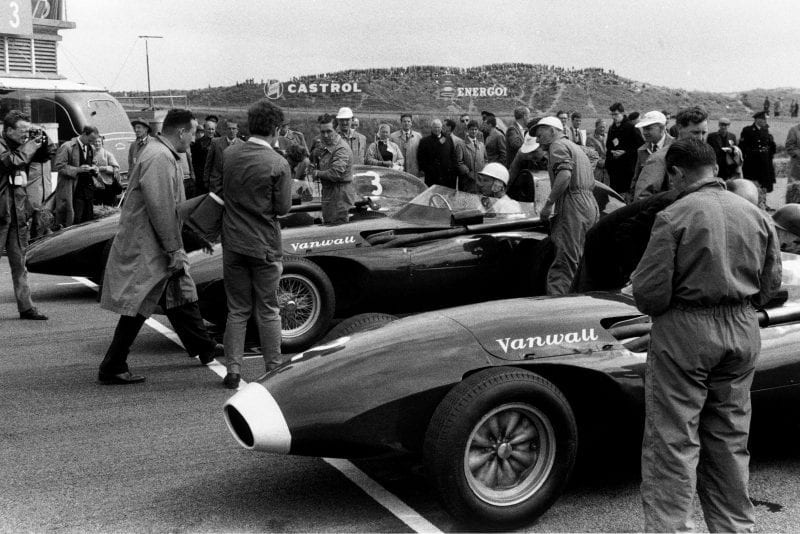
A Vanwall front row, Tony Brooks in VW7, Stirling Moss, in aVW10, and Stuart Lewis-Evans, Vanwall VW5, on the grid before the start.
Motorsport Images
Collins equalled Hawthorn’s best with 4min 00.6sec, and then Musso did 4min 00.2sec, while Moss was hovering on the brink of beating both of them. All this competition rather overshadowed the efforts of the “tiddlers,” but Allison was really enjoying himself on this high-speed circuit and was down to 4min 10.6sec with the 2.2-litre Lotus and Brabham was 5 sec slower with the big Cooper, but before he could challenge the Lotus a main bearing broke.
Moss now tried 16″ wheels on the rear of his Vanwall as well as on the front, and the slightly lower gear it afforded, together with the already improved handling, saw him rapidly approach a 4min lap, and then he did an electrifying 3min 57.6sec, which really staggered everyone, and followed with another at 3min 59.0sec, then stopped, leaving Ferrari to ponder on the performance of the Vanwall.
In the Maserati pits the new car was still standing unused until near the end of practice Maston Gregory did a few tentative laps in it at around 4min 18sec, but it was very much in the nature of a test-run to make sure everything was working all right. With Moss making such a shattering lap time and Hawthorn, Collins and Musso hovering close to 4min, any other times seemed slow by comparison, but Gendebien was making a good impression on his first outing in a Dino V6 Ferrari and his best lap, in 4min 03.7sec, was very creditable, while Schell did a worthy 4min 07.4sec in the 1958 BRM.
It was now pretty obvious that the circuit had been modified and speeded up until it was potentially faster than the cars’ capabilities, so that extreme accuracy of selection of axle ratios was critical, the speed differential between the cars not being very large and the circuit not allowing any marked superiority of driving among the top few to show any great difference on time.
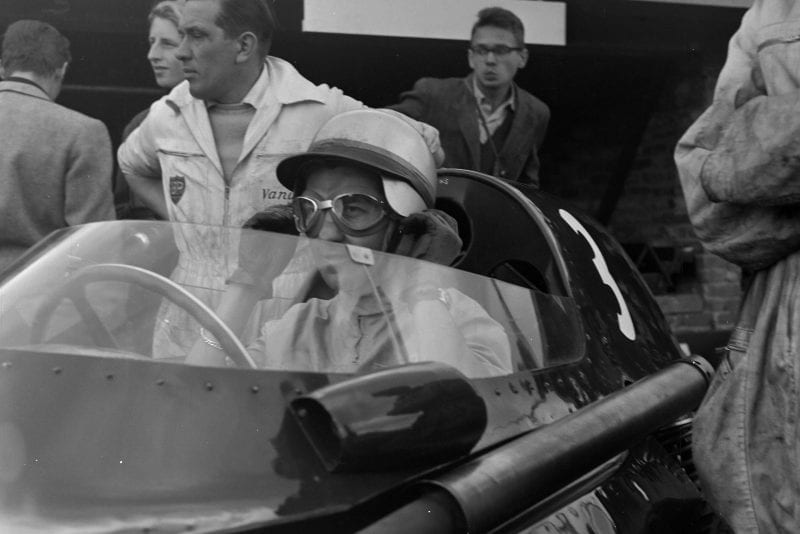
Vanwall driver Stuart Lewis-Evans, int he cockpit.
Motorsport Images
On the Saturday practice was held in the afternoon from 3pm to 5pm, so that final carburation and tyre settings could be approximated for race day, the race being scheduled to start at 4pm on Sunday. Everyone was out for a final fling, the starting grid being arranged according to the best times of the three days’ practice. Moss and the Vanwall team were so sure that their time of 3min 57.6sec would not be approached that his car was not taken to practice, the time being spent on making sure it was in 100% condition for the race.
Brooks was soon circulating rapidly, and almost before everyone was under way he did 4min 00.5sec and then 3min 59.1sec, so now Vanwalls were one and two. Before he could go any faster his gearbox showed signs of seizing so he stopped, and it was left to the Ferrari team to dominate the scene. BRM had repaired Behra’s 1958 car and he was going a lot quicker than before, but it was clear that the Bourne machine had insufficient maximum speed or power to approach the leaders.
Brabham was pressing along in the Cooper, now with a 1,960cc engine fitted, and Allison was down to 4min 07.7sec, while Hill in the smaller Lotus was keeping ahead of some of the Maseratis but was still learning about really high-speed driving. Hawthorn now led the attack on the apparent Vanwall supremacy, and after a number of laps at close on 4min he did 3min 57.1sec, a heroic effort and ftd Brooks could not retaliate as his gearbox was in trouble, and poor Moss had to sit and watch, his car being back in the garage in pieces, only Lewis-Evans having a Vanwall available and he just not being quick enough to worry the Ferraris, his best time being 4min 07.2sec.
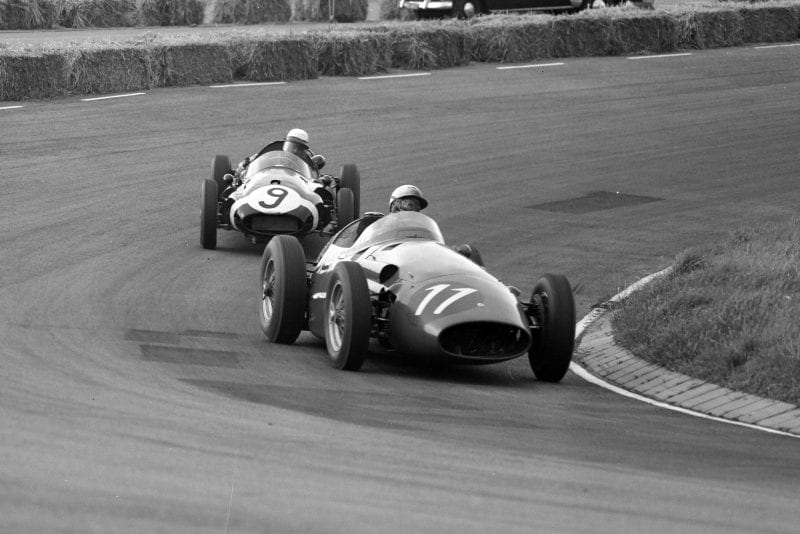
Jo Bonnier driving a Maserati 250F, leads Maurice Trintignant in his Cooper T45 Climax.
Motorsport Images
Having nothing to drive for the time being, Maserati lent Moss a new experimental sports car they had with them, this being a V12 cylinder 3-litre engine in a modified 300S chassis. After a pause all four Ferraris went out again and as if to show that Hawthorn’s time was not a fluke, Collins did 3min 57.7sec and Musso did 3min 57.5sec, and the Vanwall team had to sit by helplessly, unable to defend their positions in the front row of the starting grid.
“Almost unnoticed, due to the excitement among the top boys, Brabham had recorded a remarkable 4 min. 05.1 sec”
The order now Hawthorn, Musso, Moss, Collins, Brooks, all well under 4min, while Gendebien was still working really hard to try and achieve the magic 4min lap. Gregory was by far the fastest Maserati driver and while he took the new works Maserati out for a few laps he lent the blue-and-white one to Trintignant. Almost unnoticed, due to the excitement among the top boys, Brabham had recorded a remarkable 4 min. 05.1 sec. with the 2-litre Cooper, beating Gregory’s best time with the old Maserati. his best time with the new works car being 4 min. 11.0 sec.
Towards the end of the afternoon Gendebien was still trying hard and just before practice ended he did a lap in 4min. 00.5sec, and followed this with an excellent 3min 59.3sec, thus getting the fourth Ferrari under the 4min mark. While Ferraris were rejoicing at the end of practice and Vanwalls were wondering. Maserati were most unhappy for Kavanagh, after beating Godia, broke a rod and wrecked his engine, Gregory broke a valve while doing 7,800rpm down the straight, and Bonnier had his propeller-shaft break, narrowly missing very serious physical injury. It had been quite an afternoon, and the sun had shone brilliantly all the while.
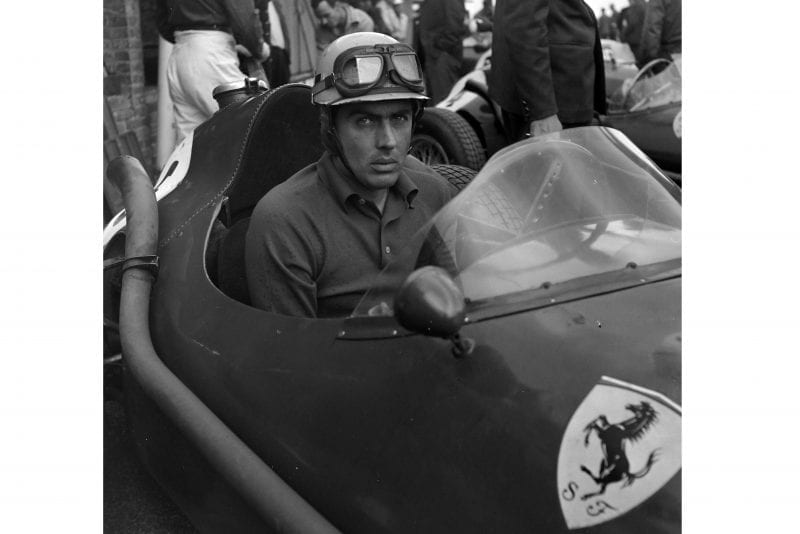
Luigi Musso in his Ferrari 246.
Motorsport Images
Overnight Vanwall fitted a new gearbox to Brooks’ car, and Maserati repaired Bonnier’s car and bodged-up Gregory’s engine and hoped that it would at least start, but Kavanagh’s engine was beyond repair. Ferrari polished all their cars and went to bed early. As the race was in the nature of a sprint event, being over a mere 24 laps and 338 kilometres (approximately 210 miles), and would probably last less than 1¾ hours if the practice speeds were anything to go by, the Royal Automobile Club of Belgium were faced with a lot of spare time on their hands, especially as the Grand Prix was due to start at 4pm.
As the FIA had given the race the title of the Grand Prix of Europe, for what that is worth, it would have been nice to have seen a reasonable length of race visualized; instead the day was filled up with a series of carnival acts, first there being a parade of Bugatti cars organised by the BOC of Holland, and then there being a handicap race for touring and grand touring cars open to Belgian drivers and lesser foreign drivers; though amusing for the competitors it did not really have a place at such a meeting.
Race
An hour before the start of the Grand Prix the sun was really hot, and then a parade of drivers took place in real Hollywood film-star style, each driver sitting on the back of an open two-seater, such as 190SL, 300SL, Giulietta, etc, with his (or her) name on a huge placard across the front of the car, and they were driven slowly round the circuit for the crowd to applaud.
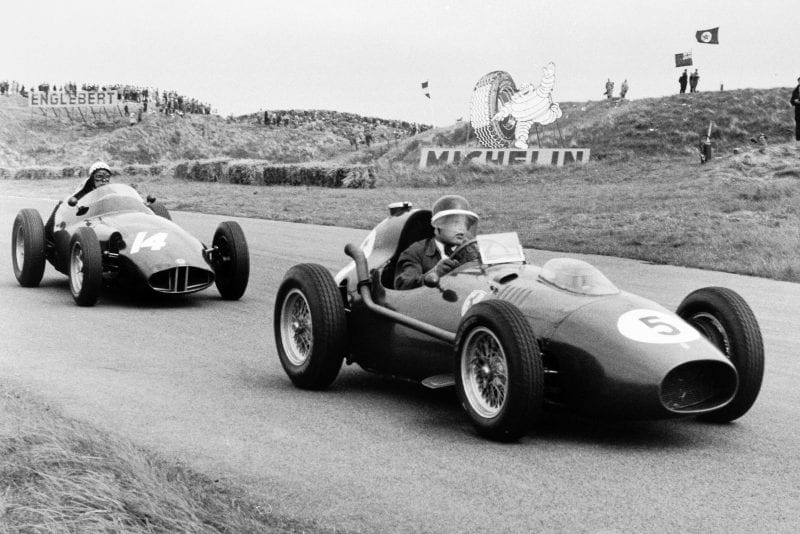
Mike Hawthorn in his Ferrari Dino 246, ahead of Jean Behra in a BRM P25.
Motorsport Images
This air of carnival must have got into the Grand Prix organisers, for when the cars were given their positions on the starting grid they were lined up time wrong way round, with fastest time on the left instead of on the right. As the first corner after the start was only a few hundred yards away and it went to the left, Hawthorn pointed out the error, so the front-line positions were reversed but not the rest of the grid, so the start was as follows :
1. Hawthorn (Ferrari) 3 min 57.1sec
2. Musso (Ferrari) 3 min 57.5sec
3. Moss (Vanwall) 3 min 57.6sec
4. Brooks (Vanwall) 3 min 59.1sec
5. Collins (Ferrari) 3 min 57.7sec
6. Brabham (Cooper) 4 min 05.1sec
7. Schell (BRM) 4 min 04.5sec
8. Gendebien (Ferrari) 3 min 59.3sec
9. Behra (BRM) 4 min 06.2sec
10. Gregory (Maserati) 4 min 05.4sec
11. Salvadori (Cooper) 4 min 05.6sec
12. Allison (Lotus) 4 min 07.7sec
13. Lewis-Evans (Vanwall) 4min 07.2sec
14. Hill (Lotus) 4 min 17.9 sec
15. Bonnier(Maserati) 4 min 15.7 sec
16. Godia (Maserati) 4 min 24.5 sec
17. Seidel (Maserati) 4 min 21.9 sec
18. Trintignant (Maserati) 4 min 21.7 sec
19. de Fillipis (Maserati) 4 min 31.0 sec
Under a really hot sun the 19 cars were now ready to start and for once green cars did not dominate the scene, the three red Ferraris and Gendebien’s yellow one were well placed and out to save the honour of Italian motor racing. Although the race was to be a short one it obviously was going to be a fierce one, but, unfortunately, incompetent bungling by the starters spoilt all prospects of a good race before it was started.
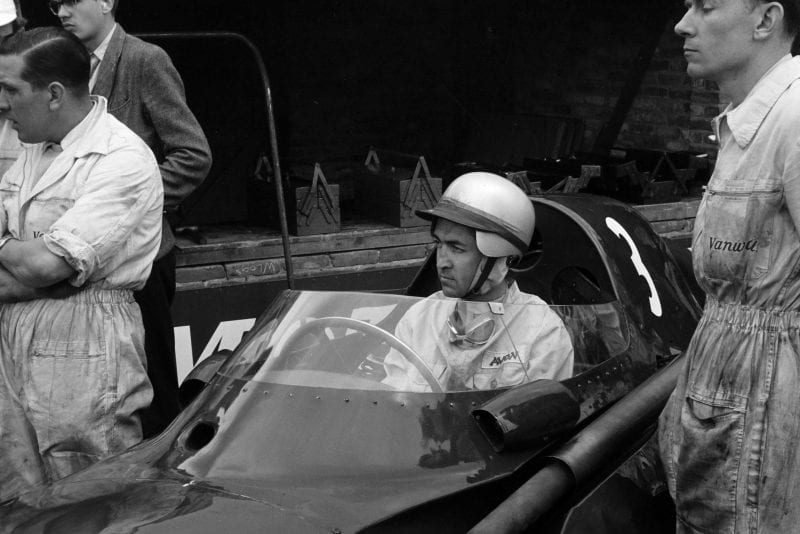
Stuart Lewis-Evans waiting in his Vanwall
Motorsport Images
The two-minute signal was given and the Ferrari mechanics waited another minute before starting their cars with the portable starters, and then everyone started up, for 60 seconds is about as long as a Grand Prix car likes to be kept waiting on the line, especially under time sweltering sun. Just as everyone was ready to go the starter signalled another minute to go, but as the last few seconds ticked by Gregory’s Maserati was still being pushed up and down, the bodged-up engine being reluctant to fire, and without giving any indication the timekeepers and starters decided to wait another 60 seconds.
Nerves were at breaking point, for a driver always anticipates the last 10 seconds and his leg begins begin to release the clutch, but now they were all straining to go and still the flag was not raised. Water temperatures were rising rapidly and then it happened, Collins’ Ferrari began to boil, the water temperature gauge needle was right off the dial and the oil temperature was dangerously high. What could the poor driver do, enveloped in steam: he could not switch off for time start was now 30 seconds away.
“The Ferrari was spewing out water and steam, and the paint on time bonnet was blistering, and any second the other cars might start boiling”
Mechanics, drivers, team-managers and onlookers all started waving and shouting, and everyone was in a high state of tension; the cars behind the front row began to creep forward while officials waved them back, and all the while the timekeeper and the starter were waiting for the last 20 seconds to pass by. Twenty seconds is not long, but under the prevailing, tension and surrounded by the excitement it seemed a lifetime.
The Ferrari was spewing out water and steam, and the paint on time bonnet was blistering, and any second the other cars might start boiling, while all the drivers were frantically watching their rising temperature gauges, the three in the front row conscious of a turmoil behind them but not really knowing what was going on.
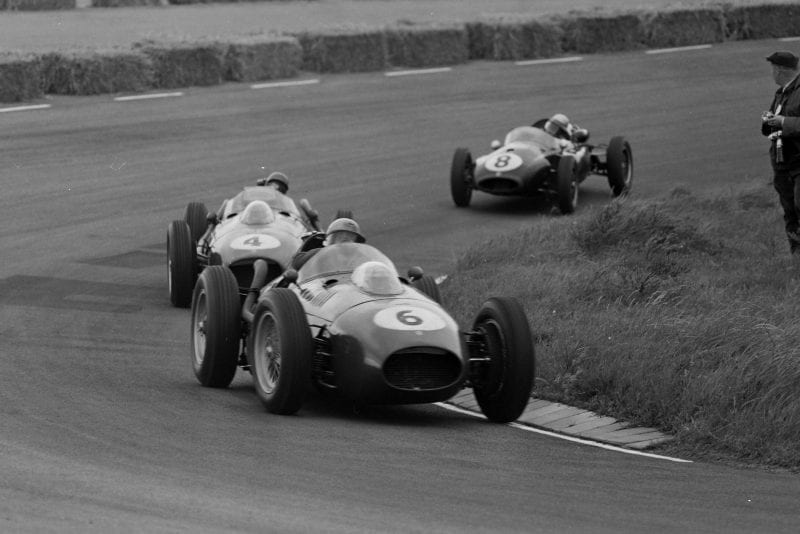
Luigi Musso in his Ferrari 246, leads Peter Collins also in a Ferrari 246, and Jack Brabham in his Cooper T45 Climax.
Motorsport Images
At 10 seconds the starter hurriedly raised the flag and dropped it, much against the wishes of the timekeeper, and the screaming pack were away. Nerves were all jangled by this time, so it was not surprising that Musso and Hawthorn muffed their starts, the Ferraris being difficult at the best of times, having no special low starting gear as on the Maseratis and Vanwalls. So it was Moss who led away, followed by Brooks. The boiling Ferrari had obscured the fact that Gregory’s Maserati had still not fired, and when all the shouting had died down he was left on the line, to be pushed away eventually, banging and misfiring in a very unhappy state. The air of carnival had certainly seeped into the Grand Prix, but unhappily it had serious consequences.
Moss led down through the Malmedy corner and along the Masta straight he had quite a considerable lead, which he increased rotund the fast Stavelot corner, but then disaster struck and whether it was the result of the starting-line chaos he would not say, but it might well have been. As he accelerated out of Stavelot in fourth gear he reached peak revs, and whipped the gear-lever back into fifth gear, but he mistimed it and it did not go in it was only a matter of one-hundredth of a second but it was enough, the revs went up to the sky and valves and inseams met each other with disastrous regales, arid the field streamed by the stricken Vanwall and its unhappy driver.
It was Brooks who led at the end of the first lap, closely pursued by Collins, whose water temperature and oil temperature were still way up in the danger zone; then came Gendebien, much to the delight of the Belgians. followed by Hawthorn, Behra, Evans, Musso, Schell and Allison, the Lotus leading the mini-cars anal all the Mageratis, while poor Gregory never re-appeared, his engine failing completely halfway round the opening lap. The next time round Collins was leading, with Brooks right on his tail, while Evans was about to pass Musso and Hawthorn already past Gendebien and in third place.
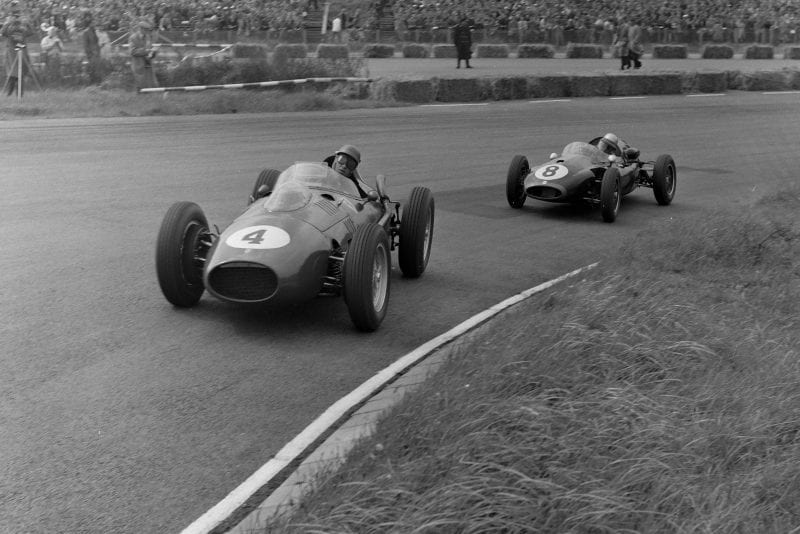
Peter Collins driving a Ferrari 246 ahead of Jack Brabham’s Cooper T45 Climax.
Motorsport Images
The standing lap had been covered in 4min 12sec, and as the tail-enders had streamed by Moss had pulled into the pits to retire and explain why the car had no compression. Brooks and Collins were really battling now, lapping at 4min 02sec, and as they passed fair the third time it was the Vanwall leading, but the Ferrari was so close it was almost obscured under the high green tail of the British car. Lap four the order was reversed, and the gap was still so small it could not be measured on an ordinary stop-watch; but it could not go on, for the Ferrari had overheated too badly on the starting line.
“The gap was still so small it could not be measured on an ordinary stop-watch”
As Gendebien braked for the hairpin before the pits at the end of the fourth lap he was struck on a rear wheel by the nose of Lewis-Evans’ Vanwall which was close behind, and the result was that the yellow Ferrari spun and bumped its nose against the inside retaining wall of the hairpin and the engine stalled. All the following cars ran round the outside, and when they had gone Gendebien had to manhandle the car backwards up the steep camber until he had enough room to swing round and roll down to the pits to have the nose beaten out so that some air could get to the radiator. He was right at the end of the field when he got away and nearly a lap behind the leader.
Meanwhile a third retirement was that of Schell, whose Maserati’s rear suspension was “acting up” and then Brooks went by on his own, followed by Hawthorn a bit later, and Collins coasted into the pits and retired. Neither the water temperature nor the oil temperature had ever shown signs of returning to normality, and when the oil pressure began to sag as a result of the overheating Collins wisely switched off before the engine broke. Behra also came in with the BRM suffering from low pressure, quite probably due to initial overheating at the start, and he retired, While on the next lap, the sixth one, Musso failed to appear, it being reported that a tyre had burst and he had skidded off the road, fortunately with no personal damage.
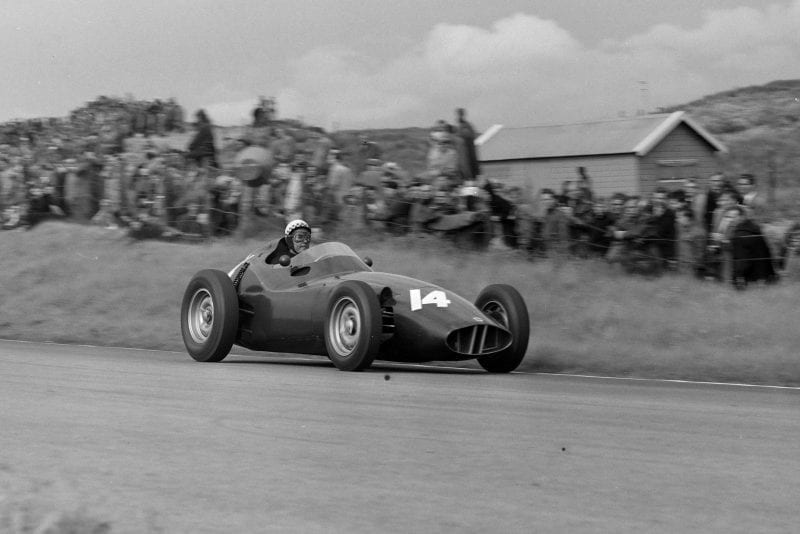
Jean Behra in his BRM P25.
Motorsport Images
Only a quarter of the race had been run and already six cars were out and all prospects of a race were now finished, a high-speed procession now developing. There were 11sec between Brooks and Hawthorn on lap seven and this increased lap by lap, until it was 37 sec by half distance, while the gap between Hawthorn and Lewis-Evans, who was in third place, had risen to 47sec. Running in fourth place was the cheeky little 2.2-litre Lotus driven by Allison, while behind him came Salvadori and Brabham, followed by the private Maseratis, with Gendebien working his way steadily past them.
Brooks had set up a lap record on lap five with 4min 00.5sec and was continuing to lap in about 4min 02.0sec (approximately 130mph), and had already lapped the last five cars; while Hawthorn was doing the same. Just as the Ferrari was about to lap Hill’s Lotus the little green car disappeared in a cloud of smoke as a con-rod came out through the side of the engine, and Hill had to be content to be a spectator from then on. Brabham called in for water and Salvadori enlivened things by passing Allison’s Lotus, but he led for only three laps and then the Lotus retook fourth place and the Cooper’s clutch began to slip.
With 10 laps to go Brooks had 41sec lead and began to take things a little easier, but not for long, for Hawthorn now began to pile on speed in a last do-or-die effort, first of all setting a new lap record in 3min 59.3sec and then reducing the Vanwall’s lead steadily every lap. Brabham retired with head-gasket troubles and then Godia went out with a broken piston, and Brooks retaliated to Hawthorn’s challenge with a lap in 3min 59.7sec, not a record but sufficient to stem the Ferrari’s onslaught.

Stirling Moss is handed a cigarette and a drink following his victory.
Motosport Images
All this time Lewis-Evans was running in third place, driving quietly and steadily, with no hope of challenging the leaders but way ahead of the fourth car, which was still the Lotus putting up a remarkable run and still not lapped by the leader, all the rest of the 10 runners long since having been lapped, including even Schell in the BRM, who was lying fifth. It was now virtually all over, little more than 1½ hours after the start, and as Brooks rounded the Source hairpin for the last time and accelerated down to the chequered flag something tightened up in the Vanwall gearbox and it was fortunate he did not have to do another lap.
Less than half a minute later Hawthorn stormed down the hill to the finish and just before crossing the line a piston broke and a cloud of white smoke shot out of the exhaust, and the Ferrari was flagged second with a ruined engine, but Hawthorn had the satisfaction of setting up a new lap record on that last lap with a time of 3min 58.3sec, and he had not taken the engine over the permitted 8500rpm. The last lap had not finished reaping havoc for Lewis-Evans arrived in third place going quite slowly for the top right-hand wishbone out the Vanwall had broken! The first car to arrive in a fit and healthy no after this very high-speed event was Allison’s Lotus in fourth place, and if there had been another lap to go it might possibly have been in 1st place, which would have really confounded the experts.
Francorchamps Flippancies
- When it was all over many people wondered when the real race was going to start, feeling that 1 hr. 37 min. could not have seen the running of the Grand Prix of Europe. If the F.I.A. go on encouraging this sort of thing we shall soon have to go to Silverstone Club meetings to watch really arduous racing.
- In case anyone missed the “carnival atmosphere” at the start, the programmes were all printed with lap charts giving the race length as 30 laps instead of 24. Many spectators round the circuit thought the race had been stopped prematurely.
- Grand Prix racing seems to be coming popular; there were as many visitors from Britain at Francorchamps as one normally sees at Le Mans.
- After the broken wishbone at Rouen the Lotus team did not go so far as to redesign the front end on the single-seaters, lout at least they scratched the paint off some vital parts to make sure there were no cracks developing.
- As a specially-built high-speed racing track; as distinct from a road-racing circuit. Francorchamps is now undoubtedly the finest in Europe. The lap record of over 213 k.p.h. will surely make Raymond Roche file off some of the corners of the Reims circuit, which used to be the fastest.
- For the race Moss had wire-spoke wheels on the front and alloy wheels on the rear, while the other two cars had alloy wheels all round.
- Many people were surprised at the speed of the Dino Ferraris, but it is the first time they have. had a chance to get really wound up in top gear. On the question of roadholding; the case is similar to the Super-Squalo Ferrari of 1955.
